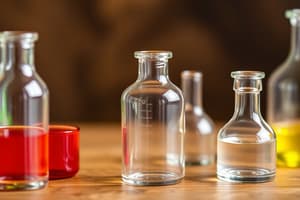Podcast
Questions and Answers
What does the Law of Definite Proportions state regarding the composition of a compound?
What does the Law of Definite Proportions state regarding the composition of a compound?
It states that the percent composition of a compound must have a unique value regardless of the sample analyzed.
How does the Law of Multiple Proportions differ from the Law of Definite Proportions?
How does the Law of Multiple Proportions differ from the Law of Definite Proportions?
The Law of Multiple Proportions states that if two elements form multiple compounds, the mass ratios of one element with a fixed mass of the other are in small whole numbers.
What was Rutherford's significant contribution to atomic theory in 1911?
What was Rutherford's significant contribution to atomic theory in 1911?
Rutherford concluded that the atom consists of a small, dense, positive nucleus surrounded by electrons at large distances.
What was the expected outcome of Rutherford's gold foil experiment?
What was the expected outcome of Rutherford's gold foil experiment?
What observation led Rutherford to deduce the existence of the nucleus?
What observation led Rutherford to deduce the existence of the nucleus?
Define atomic number and its significance.
Define atomic number and its significance.
What did Dalton's proposition about the Law of Conservation of Mass indicate?
What did Dalton's proposition about the Law of Conservation of Mass indicate?
How did Thomson's 'Plum Pudding' model conceptualize atom structure?
How did Thomson's 'Plum Pudding' model conceptualize atom structure?
What does Dalton's Atomic Theory propose about atoms?
What does Dalton's Atomic Theory propose about atoms?
How does the Law of Conservation of Mass apply in a chemical reaction?
How does the Law of Conservation of Mass apply in a chemical reaction?
Differentiate between atomic number and mass number.
Differentiate between atomic number and mass number.
What are isotopes, and how are they represented?
What are isotopes, and how are they represented?
Give an example differentiating between an atom and a molecule.
Give an example differentiating between an atom and a molecule.
What is the significance of the Law of Definite Proportions?
What is the significance of the Law of Definite Proportions?
How would you write the isotopic symbol for Carbon-14?
How would you write the isotopic symbol for Carbon-14?
What is the role of ions in forming compounds?
What is the role of ions in forming compounds?
What does the law of conservation of mass state, and how is it demonstrated in the reaction of CaCO3?
What does the law of conservation of mass state, and how is it demonstrated in the reaction of CaCO3?
How does the law of definite proportions apply to the composition of water?
How does the law of definite proportions apply to the composition of water?
According to the law of multiple proportions, what is the significance of the ratios of masses between elements?
According to the law of multiple proportions, what is the significance of the ratios of masses between elements?
What are the main postulates of Dalton's atomic theory regarding atoms and chemical reactions?
What are the main postulates of Dalton's atomic theory regarding atoms and chemical reactions?
What is the atomic mass of an element and why is it not a whole number?
What is the atomic mass of an element and why is it not a whole number?
What has been proven incorrect about Dalton's first postulate in light of modern science?
What has been proven incorrect about Dalton's first postulate in light of modern science?
What evidence contradicts Dalton's second postulate regarding the uniformity of atoms in an element?
What evidence contradicts Dalton's second postulate regarding the uniformity of atoms in an element?
How do you calculate the weighted average of isotopes for an element?
How do you calculate the weighted average of isotopes for an element?
What distinguishes a molecular formula from an empirical formula?
What distinguishes a molecular formula from an empirical formula?
In the reaction where KOH reacts with CO2, how much potassium carbonate is produced from 224.4g of KOH and 88.0g of CO2?
In the reaction where KOH reacts with CO2, how much potassium carbonate is produced from 224.4g of KOH and 88.0g of CO2?
What is the significance of the structural formula in chemistry?
What is the significance of the structural formula in chemistry?
Explain how the law of conservation of mass is illustrated through the potassium hydroxide and carbon dioxide reaction.
Explain how the law of conservation of mass is illustrated through the potassium hydroxide and carbon dioxide reaction.
What are isotopes, and how do they differ from each other?
What are isotopes, and how do they differ from each other?
Why is carbon-12 the most abundant isotope in nature?
Why is carbon-12 the most abundant isotope in nature?
Give an example of a molecule and explain its molecular formula.
Give an example of a molecule and explain its molecular formula.
How does the chemical bonding affect the properties of molecules?
How does the chemical bonding affect the properties of molecules?
What distinguishes a cation from an anion?
What distinguishes a cation from an anion?
How do you determine the total charge of an ionic compound?
How do you determine the total charge of an ionic compound?
What is the empirical formula of hydrogen peroxide (H2O2), and how does it differ from its molecular formula?
What is the empirical formula of hydrogen peroxide (H2O2), and how does it differ from its molecular formula?
Explain the significance of Dalton's model of the atom in the historical context of atomic theory.
Explain the significance of Dalton's model of the atom in the historical context of atomic theory.
What is the charge of the polyatomic ion sulfate ($SO_4^{2-}$), and what does this signify about electron transfer?
What is the charge of the polyatomic ion sulfate ($SO_4^{2-}$), and what does this signify about electron transfer?
Differentiate between simple ions and polyatomic ions.
Differentiate between simple ions and polyatomic ions.
What role did J.J. Thomson's 'plum-pudding' model play in the development of atomic theory?
What role did J.J. Thomson's 'plum-pudding' model play in the development of atomic theory?
Identify one key feature of the charge-cloud model of the atom and its importance in modern chemistry.
Identify one key feature of the charge-cloud model of the atom and its importance in modern chemistry.
Flashcards are hidden until you start studying
Study Notes
Session Objectives
- Explain the basic laws of matter: Law of Conservation of Mass, Law of Definite Proportion, and Law of Multiple Proportions.
- Describe Dalton’s Atomic Theory.
- Differentiate atomic number, mass number, isotopes, and their roles in distinguishing elements.
- Write isotopic symbols.
- Differentiate atoms, molecules, and ions; provide examples.
- Name compounds from their formulas and write formulas based on compound names.
Historical Background of Atomic Structure
- Greeks in 400 B.C. theorized matter was made of earth, wind, fire, and air.
- Democritus introduced the concept of "atomos" (indivisible particles), laying foundational ideas about atoms.
- Atoms are defined as the basic units of matter.
Laws of Chemical Changes
- Law of Conservation of Mass: Mass is neither created nor destroyed in chemical reactions.
- Example: The mass of reactants equals the mass of products.
- Law of Definite Proportion: A compound always has a fixed composition by mass regardless of the sample source.
- Example: Pure water has consistently 11.19% hydrogen and 88.81% oxygen.
- Law of Multiple Proportions: If two elements can form multiple compounds, the masses of one element with a fixed mass of another are in ratios of small whole numbers.
Dalton’s Atomic Theory
- Atoms are small particles that cannot be created or destroyed.
- All atoms of an element are identical, differing from other elements.
- Compounds consist of atoms combined in whole-number ratios.
- Chemical reactions rearrange atoms but do not change them.
Models of Atomic Structure
- Ernest Rutherford’s Atom Model: Introduced the nucleus, concluding that atoms are mostly empty space with a dense positive center, deflecting alpha particles.
- Modern Atomic Structure: Comprised of protons and neutrons in the nucleus with electrons surrounding it.
Atomic and Mass Numbers
- Atomic Number (Z): Equal to the number of protons in the nucleus; unique to each element.
- Mass Number: Total number of protons and neutrons in an atom’s nucleus.
- Isotopes: Variants of an element with the same number of protons but different numbers of neutrons.
Molecular and Empirical Formulas
- Molecular Formula (MF): Indicates the actual number of atoms in a molecule (e.g., H2O2 for hydrogen peroxide).
- Empirical Formula (EF): Shows the simplest whole-number ratio of elements (e.g., HO for hydrogen peroxide).
- Structural Formula: Describes how atoms are connected in a molecule.
Ions
- Ions: Charged particles formed when atoms gain or lose electrons.
- Cations: Positively charged ions formed by metals.
- Anions: Negatively charged ions formed by nonmetals.
- Polyatomic Ions: Ions composed of more than one atom.
Ionic Compounds
- Comprised of cations and anions, resulting in neutral compounds.
- The total positive charge equals the total negative charge in an ionic compound.
Models of the Atom Timeline
- Dalton’s Model (1803): Atoms as tiny, indestructible spheres.
- Thomson’s Plum-Pudding Model (1897): Electrons embedded in a positively charged "pudding."
- Rutherford’s Model (1911): Discovery of a small, dense nucleus.
- Bohr’s Model (1913): Electrons move in fixed orbits around the nucleus.
- Charge-cloud Model: Current understanding of electron behavior using probability rather than fixed orbits.
Studying That Suits You
Use AI to generate personalized quizzes and flashcards to suit your learning preferences.





